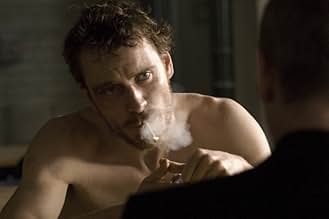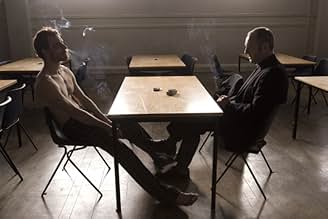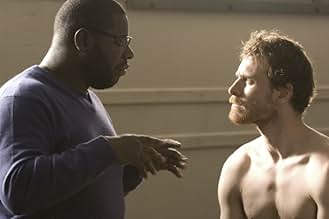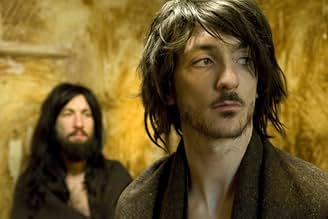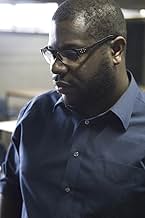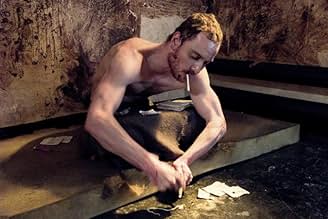CALIFICACIÓN DE IMDb
7.5/10
75 k
TU CALIFICACIÓN
Bobby Sands, un republicano irlandés lidera a los reclusos de la prisión de Irlanda del norte en una huelga de hambre.Bobby Sands, un republicano irlandés lidera a los reclusos de la prisión de Irlanda del norte en una huelga de hambre.Bobby Sands, un republicano irlandés lidera a los reclusos de la prisión de Irlanda del norte en una huelga de hambre.
- Dirección
- Guionistas
- Elenco
- Ganó 1 premio BAFTA
- 49 premios ganados y 39 nominaciones en total
- Dirección
- Guionistas
- Todo el elenco y el equipo
- Producción, taquilla y más en IMDbPro
Opiniones destacadas
This debut from former artist turned director Steve McQueen will leave you breathless. In its own understated way it is epic, bold, brutal and beautiful. Telling the story of the last six weeks in the life of Bobby Sands the Irish republican hunger striker the film pulls no punches in showing life inside the maze prison and what the prisoners did to try and win political status. From the outset the shots are amazing with McQueen utilising his artistic eye to bring the best out of the very cold prison environment, his attention to detail is simply stunning making every single frame fantastically watchable despite the sometimes gruesome subject matter. Also his approach of less is more adds to the atmosphere as he has shots that have no sounds or music, like the guard cleaning the corridor with its fixed camera unflinching for several minutes the only sound the eerie echoing scrubbing. Unofficially split into three the first part deals with the incarceration and subsequent no wash protests while the last deals with the hunger strikes but it's the central piece that separates which most will remember for its ability to captivate despite just being a conversation between Sands and a visiting priest. Again shot from a fixed angle and superbly lit Sands (Fassbender) explains the morality behind his decision to stop eating. The acting and the monologue will stay with you long after the films finished and cements actor Fassbender firmly in the role to the point where you start to feel for him as he begins to waste away. When the film premiered at Cannes it caused walkouts and standing ovations before walking away with the Camera d'Or for best debut and rightly so, not only is it one of the best films of the year it is one of the most powerful I've seen. Regardless of where you stand politically the message is universal and just like the circle of faeces smeared on Sands cell wall, McQueen has crafted something beautiful out of something horrible.
Hunger is a low budget film from a production company more recognisable for its TV work, without any recognisable stars, without a really big distributer to get it around and directed by a Turner Prize winning visual artist making his film debut. Already you would perhaps be considering giving it a miss and maybe this isn't the best time to mention it is a largely dialogue free account of hunger-striker Bobby Sands set entirely in Northern Ireland's infamous Maze prison. This is probably one of the reasons that the film hasn't been as widely seen as it deserves to be or why audiences haven't flocked into screenings of it on a Saturday night. Certainly it is not an easy watch given the subject matter alone but yet it is a compelling and quite brilliant film.
Although the nature of the story leads the viewer to be emotionally invested in one "side" of the situation, McQueen never does anything that opens his film to this suggestion of bias or of scoring political points, if anything his attention to the detail of the tightly focused story does just the opposite. As well as telling us how many hunger strikers died, he point out how many prison guards were murdered during the period and, in my favourite part, introduces us to the prison via one guard soothing his hands (which tells us the frequency of what he does). It is a nice moment but not as telling as the thrill the viewer gets as he checks for bombs and starts his car we are supposed to be on the edge of our seat and we are, swiftly followed by the realisation that this is an experience we would repeat if we were in his driveway the next day or the next.
From here we move into a nearly dialogue free thirty minute opening where no central character really comes forward and our "focus" is on life in the prison for guards and prisoners a story that almost starts without there being a "story". The film later brings Bobby Sands to the fore, delivering one impressive dialogue scene before returning to a dialogue-light charting of his hunger strike on the way to the conclusion that we all know is coming. Yet it manages to be really engaging because of the level of each detail in each scene and the relevance of each scene to the overall film. The scene that has gotten all the mentions and praise is the long dialogue scene between Sands and the priest who comes to see him before his strike. Filmed in three distinct shots, the scene is technically impressive but also allows the main dialogue delivery of the film and the only really moment where anyone is allowed to debate and discuss the actions. Even here McQueen does not allow sides to be taken but keeps it as two men talking. It is engaging, really well written and of course, really well acted.
It is ironic that in this scene the film sits still for ages and allows the frame to remain the same because for the majority of the film McQueen's camera is the star. So many shots are striking that it almost becomes "normal" to be transfixed by an image on the screen. Whether it be a excrement-smeared cell, urine flowing down a hall or a man washing blood from his hands, it looks great and the care taken to construct each image fills the "gap" that the dialogue leaves. The performances are mostly very good and compliment the "few words" approach by bringing a lot when required and wearing their characters convincingly. There are some you may recognise but I didn't. Fassbender is the most memorable as he has the biggest character and the most startling journey, but this should not take away from smaller turns from Graham, Mullen and a few others who are also good. The film is not perfect though. The uninitiated may struggle to understand the bigger picture as you don't get a lot of help with that and those that don't get into the telling initially may be left cold by the approach. However these "weaknesses" are not missed targets or failings but rather the "cons" that have to come with the overwhelming pros of the manner of delivery.
Hunger is not an easy film to watch but it is a great film. It is wonderfully shot with an artist's composure but McQueen is not a "visual style" director who doesn't come with anything else (list your own failed music video director turned film director here) but rather he uses this approach to improve the film and make the telling better. The acting is impressive because of how real they feel and how little dialogue they have across the whole film, but to me the real star was McQueen. He is a visual artist and it shows as he makes the majority of his shots striking and engaging, even if they are not "beautiful". It may get a bit more exposure due to awards chatter but even if it doesn't it is certainly worth checking out.
Although the nature of the story leads the viewer to be emotionally invested in one "side" of the situation, McQueen never does anything that opens his film to this suggestion of bias or of scoring political points, if anything his attention to the detail of the tightly focused story does just the opposite. As well as telling us how many hunger strikers died, he point out how many prison guards were murdered during the period and, in my favourite part, introduces us to the prison via one guard soothing his hands (which tells us the frequency of what he does). It is a nice moment but not as telling as the thrill the viewer gets as he checks for bombs and starts his car we are supposed to be on the edge of our seat and we are, swiftly followed by the realisation that this is an experience we would repeat if we were in his driveway the next day or the next.
From here we move into a nearly dialogue free thirty minute opening where no central character really comes forward and our "focus" is on life in the prison for guards and prisoners a story that almost starts without there being a "story". The film later brings Bobby Sands to the fore, delivering one impressive dialogue scene before returning to a dialogue-light charting of his hunger strike on the way to the conclusion that we all know is coming. Yet it manages to be really engaging because of the level of each detail in each scene and the relevance of each scene to the overall film. The scene that has gotten all the mentions and praise is the long dialogue scene between Sands and the priest who comes to see him before his strike. Filmed in three distinct shots, the scene is technically impressive but also allows the main dialogue delivery of the film and the only really moment where anyone is allowed to debate and discuss the actions. Even here McQueen does not allow sides to be taken but keeps it as two men talking. It is engaging, really well written and of course, really well acted.
It is ironic that in this scene the film sits still for ages and allows the frame to remain the same because for the majority of the film McQueen's camera is the star. So many shots are striking that it almost becomes "normal" to be transfixed by an image on the screen. Whether it be a excrement-smeared cell, urine flowing down a hall or a man washing blood from his hands, it looks great and the care taken to construct each image fills the "gap" that the dialogue leaves. The performances are mostly very good and compliment the "few words" approach by bringing a lot when required and wearing their characters convincingly. There are some you may recognise but I didn't. Fassbender is the most memorable as he has the biggest character and the most startling journey, but this should not take away from smaller turns from Graham, Mullen and a few others who are also good. The film is not perfect though. The uninitiated may struggle to understand the bigger picture as you don't get a lot of help with that and those that don't get into the telling initially may be left cold by the approach. However these "weaknesses" are not missed targets or failings but rather the "cons" that have to come with the overwhelming pros of the manner of delivery.
Hunger is not an easy film to watch but it is a great film. It is wonderfully shot with an artist's composure but McQueen is not a "visual style" director who doesn't come with anything else (list your own failed music video director turned film director here) but rather he uses this approach to improve the film and make the telling better. The acting is impressive because of how real they feel and how little dialogue they have across the whole film, but to me the real star was McQueen. He is a visual artist and it shows as he makes the majority of his shots striking and engaging, even if they are not "beautiful". It may get a bit more exposure due to awards chatter but even if it doesn't it is certainly worth checking out.
1981.
The H block in Belfast's Maze Prison.
This film captures the development and escalation of protest by the 'political' prisoners held here as things moved through 'The 'Blanket protest' onto 'The Dirty Protest" and finally to 'The Hunger Strikes' that claimed Bobby Sands and eight of his compatriot's lives.
As the end credits of the film show, the enemy, in the form of Margaret Thatcher was 'not for turning' and did not grant political status to these men that she considered no more than murderers. They did, however, lead to many concessions - bit by bit.
This astounding movie falls into three very clear sections; the gut wrenching blanket and dirty protest; a long and deeply personal conversation (in one 20 minute take) between Sands and his priest where Sands is asked to justify and then walk away from the impending hunger strike; and finally Sands' ordeal itself.
Each section has a different pace and personality. Each is desperate in its own way.
This film pulls few punches. The stench of human excrement is almost palpable in the opening act and the way in which Michael Fassbender brings Sands' death to the screen is almost unbearable.
But the real triumph of the film is that it takes no political sides and makes no judgements but does not sit on the fence. How? Because it invokes the viewer to do that themselves. Sands is neither a figure to pity or to vilify. It really is quite remarkable that the artist Steve McQueen can achieve this so consistently.
And this is art with a capital A. Every scene is stunningly rendered. The pace, at times snail-like, allows you consider in real detail the situation these men found themselves in (or created however you want to look at it).
Fassbender's performance is miraculous.
McQueen though, is the star of the show. One scene in particular when the men slop out by pouring their night's urine under the doors of the corridor simultaneously is quite beautiful, as is the Hirst-like art that some of them create from their excrement (that's what makes up the poster image).
Film of the year. No contest.
Incidentally we saw it in the DCA's Cinema 2. What a cracking screen.
(As we scoffed coffee and fudge doughnuts. How's that for irony?)
The H block in Belfast's Maze Prison.
This film captures the development and escalation of protest by the 'political' prisoners held here as things moved through 'The 'Blanket protest' onto 'The Dirty Protest" and finally to 'The Hunger Strikes' that claimed Bobby Sands and eight of his compatriot's lives.
As the end credits of the film show, the enemy, in the form of Margaret Thatcher was 'not for turning' and did not grant political status to these men that she considered no more than murderers. They did, however, lead to many concessions - bit by bit.
This astounding movie falls into three very clear sections; the gut wrenching blanket and dirty protest; a long and deeply personal conversation (in one 20 minute take) between Sands and his priest where Sands is asked to justify and then walk away from the impending hunger strike; and finally Sands' ordeal itself.
Each section has a different pace and personality. Each is desperate in its own way.
This film pulls few punches. The stench of human excrement is almost palpable in the opening act and the way in which Michael Fassbender brings Sands' death to the screen is almost unbearable.
But the real triumph of the film is that it takes no political sides and makes no judgements but does not sit on the fence. How? Because it invokes the viewer to do that themselves. Sands is neither a figure to pity or to vilify. It really is quite remarkable that the artist Steve McQueen can achieve this so consistently.
And this is art with a capital A. Every scene is stunningly rendered. The pace, at times snail-like, allows you consider in real detail the situation these men found themselves in (or created however you want to look at it).
Fassbender's performance is miraculous.
McQueen though, is the star of the show. One scene in particular when the men slop out by pouring their night's urine under the doors of the corridor simultaneously is quite beautiful, as is the Hirst-like art that some of them create from their excrement (that's what makes up the poster image).
Film of the year. No contest.
Incidentally we saw it in the DCA's Cinema 2. What a cracking screen.
(As we scoffed coffee and fudge doughnuts. How's that for irony?)
Bobby Sands (Michael Fassbender) did something that was a risk, one that would have made others squirm or back out. He was in prison already for four or more years, as a leader in the IRA in Ireland, when he decided to go on a hunger strike. Not just him, mind you, but others along with him, who would all go hungry and, more than possibly, put their bodies on the line for the sake of their brothers in the war, until Britain did something. But the brilliance of Hunger is that director Steve McQueen (not to be confused with the action star) gives us a very straightforward (shockingly so) view of the conditions at the prison, the cell-block where IRA members were put in cells, inhumanely in fact, with feces commonly strewn on the walls and prisoners regularly beaten by SWAT teams and prison guards in general... then, after a very long scene of talk where Sands hears his own plan in front of a priest, the hunger strike in action. It's unrelenting cinema.
It's also sometimes a bit much to take in. You have to know this is not at all melodramatic, but done with little dialog, sometimes in just a few words or whispers (a female narrator pops up once or twice to put things into a sort of context), and compositions that bring out claustrophobia and the endless time spent in the prison. One might wonder why McQueen chooses to keep a shot going for so long on something as trivial, or just routine, as a guard cleaning up the urine left by all the prisoners in the hallways (all in one shot), but it's about that really: the routine of a horrible process of living, of 'us' and 'them' between the prisoners and the guards in this Northern Ireland prison, with Sands as a sort of unofficial leader inside. The length of shots, and the moments where characters burst out in anger and rage, are deliberate and dramatic and powerful.
If I had any problem with Hunger, it's that it is misleading in its first half hour. We're given two prisoners, not Sands, and a prison guard, and we're shown the horrid conditions of living in a solitary-confined prison (feces on the wall, anyone?). But Bobby Sands, the main character, isn't introduced for quite a while. It's an outstanding scene when he is introduced, kicking and pounding and getting beaten down as his hair and beard are cut, yet by then it's been perhaps too long to get to this point. It's also jarring how McQueen structures his film it terms of silent and sound: there's a fifteen minute stretch (almost all in one two-shot) where there's nothing but dialog between Sands and the priest (albeit a riveting conversation about sacrifice and humanity), but aside from this it's all just watching first the IRA members in the horror of prison conditions, and second Sands in his deterioration of the hunger strike.
And yet it is a powerful experience and a stunning debut. It reminds me a little like The Machinist in observing its lead character fade away, literally, before our eyes, only here the stakes are far greater than a tricky neo-noir plot. Fassbender is also mesmerizing for any given moment he's on screen. And yet as great as the film ultimately may be, or is, I don't have a desire to watch it again. It's about as bleak as a rainy day in Dublin - I mean a real rainy day. You won't feel good when the movie ends, but you'll know you have seen the emergence of a filmmaker with something to say, and an actor who will go to the limits, much like Christian Bale, for the sake of the character's importance in the story. Frankly, it rarely gets more dramatic and life-or-death than Bobby Sands.
It's also sometimes a bit much to take in. You have to know this is not at all melodramatic, but done with little dialog, sometimes in just a few words or whispers (a female narrator pops up once or twice to put things into a sort of context), and compositions that bring out claustrophobia and the endless time spent in the prison. One might wonder why McQueen chooses to keep a shot going for so long on something as trivial, or just routine, as a guard cleaning up the urine left by all the prisoners in the hallways (all in one shot), but it's about that really: the routine of a horrible process of living, of 'us' and 'them' between the prisoners and the guards in this Northern Ireland prison, with Sands as a sort of unofficial leader inside. The length of shots, and the moments where characters burst out in anger and rage, are deliberate and dramatic and powerful.
If I had any problem with Hunger, it's that it is misleading in its first half hour. We're given two prisoners, not Sands, and a prison guard, and we're shown the horrid conditions of living in a solitary-confined prison (feces on the wall, anyone?). But Bobby Sands, the main character, isn't introduced for quite a while. It's an outstanding scene when he is introduced, kicking and pounding and getting beaten down as his hair and beard are cut, yet by then it's been perhaps too long to get to this point. It's also jarring how McQueen structures his film it terms of silent and sound: there's a fifteen minute stretch (almost all in one two-shot) where there's nothing but dialog between Sands and the priest (albeit a riveting conversation about sacrifice and humanity), but aside from this it's all just watching first the IRA members in the horror of prison conditions, and second Sands in his deterioration of the hunger strike.
And yet it is a powerful experience and a stunning debut. It reminds me a little like The Machinist in observing its lead character fade away, literally, before our eyes, only here the stakes are far greater than a tricky neo-noir plot. Fassbender is also mesmerizing for any given moment he's on screen. And yet as great as the film ultimately may be, or is, I don't have a desire to watch it again. It's about as bleak as a rainy day in Dublin - I mean a real rainy day. You won't feel good when the movie ends, but you'll know you have seen the emergence of a filmmaker with something to say, and an actor who will go to the limits, much like Christian Bale, for the sake of the character's importance in the story. Frankly, it rarely gets more dramatic and life-or-death than Bobby Sands.
It's 1981. Raymond Lohan (Stuart Graham) is a guard in the Maze Prison, Northern Ireland. Davey Gillen is a new IRA prisoner who refuses to wear prison uniforms. He's put in with Gerry who has smeared the cell with his own feces. They smuggle things in and out of the prison. Bobby Sands (Michael Fassbender) leads the prisoners in a hunger strike.
It's quiet film and full of little details. It doesn't wallow in the brutality but lets it envelop the movie. There is a realism in the movie that is more powerful than any flash or action sequence. One really gets the sense of dehumanization. Dialog is sparse but there is a great discussion between Sands and Father Dominic Moran. This is quietly brutal and some great performances including Fassbender.
It's quiet film and full of little details. It doesn't wallow in the brutality but lets it envelop the movie. There is a realism in the movie that is more powerful than any flash or action sequence. One really gets the sense of dehumanization. Dialog is sparse but there is a great discussion between Sands and Father Dominic Moran. This is quietly brutal and some great performances including Fassbender.
¿Sabías que…?
- TriviaHunger is known for its unbroken 17 minute 10 second continuous shot, in which Catholic priest Father Dominic Moran tries to talk Bobby Sands out of the Hunger Strike he and his fellow 75 IRA members plan to start. The camera remains in the same position throughout the scene. To prepare, Liam Cunningham moved into Michael Fassbender's apartment, and they rehearsed the scene 12-15 times per day. On the first day of filming, the actors got it perfect after 4 takes.
- ErroresThatcher's speech that says "the men of violence have chosen in recent months to play what may well be their last card" is shown in the film when the hunger strike is beginning, but it was actually made after Bobby Sands had died. It was made on 28th May 1981. Bobby Sands died on 5th May 1981.
- Citas
Bobby Sands: I have my belief, and in all its simplicity that is the most powerful thing.
- ConexionesFeatured in Front Row: Michael Fassbender/Kate Winslet (2017)
- Bandas sonorasIndustry
Performed by Maya Beiser
Composed by Michael Gordon
Published by Red Poppy in association with G. Schirmir, Inc.
Selecciones populares
Inicia sesión para calificar y agrega a la lista de videos para obtener recomendaciones personalizadas
- How long is Hunger?Con tecnología de Alexa
- Is "Hunger" based on a book?
- Why did Bobby Sands starve himself?
- Who 'won' the confrontation?
Detalles
- Fecha de lanzamiento
- Países de origen
- Sitio oficial
- Idiomas
- También se conoce como
- Tù Khổ Sai
- Locaciones de filmación
- Productoras
- Ver más créditos de la compañía en IMDbPro
Taquilla
- Presupuesto
- GBP 1,500,000 (estimado)
- Total en EE. UU. y Canadá
- USD 154,084
- Fin de semana de estreno en EE. UU. y Canadá
- USD 1,980
- 7 dic 2008
- Total a nivel mundial
- USD 3,185,113
- Tiempo de ejecución1 hora 36 minutos
- Color
- Mezcla de sonido
- Relación de aspecto
- 2.35 : 1
Contribuir a esta página
Sugiere una edición o agrega el contenido que falta

Principales brechas de datos
By what name was Hunger (2008) officially released in India in Hindi?
Responda



